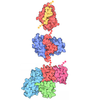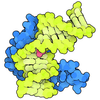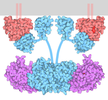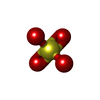[English] 日本語
 Yorodumi
Yorodumi- PDB-8xep: Crystal structure of a Legionella pneumophila type IV effector in... -
+ Open data
Open data
- Basic information
Basic information
| Entry | Database: PDB / ID: 8xep | |||||||||
|---|---|---|---|---|---|---|---|---|---|---|
| Title | Crystal structure of a Legionella pneumophila type IV effector in complex with ubiquitin | |||||||||
 Components Components |
| |||||||||
 Keywords Keywords | HYDROLASE / Legionella pneumophila / type IV effector / ubiquitin / ARHs | |||||||||
| Function / homology |  Function and homology information Function and homology informationADP-D-ribose binding / hypothalamus gonadotrophin-releasing hormone neuron development / female meiosis I / positive regulation of protein monoubiquitination / fat pad development / mitochondrion transport along microtubule / female gonad development / seminiferous tubule development / male meiosis I / positive regulation of intrinsic apoptotic signaling pathway by p53 class mediator ...ADP-D-ribose binding / hypothalamus gonadotrophin-releasing hormone neuron development / female meiosis I / positive regulation of protein monoubiquitination / fat pad development / mitochondrion transport along microtubule / female gonad development / seminiferous tubule development / male meiosis I / positive regulation of intrinsic apoptotic signaling pathway by p53 class mediator / energy homeostasis / regulation of neuron apoptotic process / neuron projection morphogenesis / regulation of proteasomal protein catabolic process / Maturation of protein E / Maturation of protein E / ER Quality Control Compartment (ERQC) / Myoclonic epilepsy of Lafora / FLT3 signaling by CBL mutants / Prevention of phagosomal-lysosomal fusion / IRAK2 mediated activation of TAK1 complex / Alpha-protein kinase 1 signaling pathway / Glycogen synthesis / IRAK1 recruits IKK complex / IRAK1 recruits IKK complex upon TLR7/8 or 9 stimulation / Endosomal Sorting Complex Required For Transport (ESCRT) / Membrane binding and targetting of GAG proteins / Negative regulation of FLT3 / Regulation of TBK1, IKKε (IKBKE)-mediated activation of IRF3, IRF7 / PTK6 Regulates RTKs and Their Effectors AKT1 and DOK1 / Regulation of TBK1, IKKε-mediated activation of IRF3, IRF7 upon TLR3 ligation / Constitutive Signaling by NOTCH1 HD Domain Mutants / IRAK2 mediated activation of TAK1 complex upon TLR7/8 or 9 stimulation / NOTCH2 Activation and Transmission of Signal to the Nucleus / TICAM1,TRAF6-dependent induction of TAK1 complex / TICAM1-dependent activation of IRF3/IRF7 / APC/C:Cdc20 mediated degradation of Cyclin B / Downregulation of ERBB4 signaling / Regulation of FZD by ubiquitination / APC-Cdc20 mediated degradation of Nek2A / p75NTR recruits signalling complexes / InlA-mediated entry of Listeria monocytogenes into host cells / TRAF6 mediated IRF7 activation in TLR7/8 or 9 signaling / TRAF6-mediated induction of TAK1 complex within TLR4 complex / Regulation of pyruvate metabolism / NF-kB is activated and signals survival / Regulation of innate immune responses to cytosolic DNA / Pexophagy / Downregulation of ERBB2:ERBB3 signaling / NRIF signals cell death from the nucleus / VLDLR internalisation and degradation / Regulation of PTEN localization / Regulation of BACH1 activity / Activated NOTCH1 Transmits Signal to the Nucleus / Synthesis of active ubiquitin: roles of E1 and E2 enzymes / MAP3K8 (TPL2)-dependent MAPK1/3 activation / Translesion synthesis by REV1 / TICAM1, RIP1-mediated IKK complex recruitment / Translesion synthesis by POLK / InlB-mediated entry of Listeria monocytogenes into host cell / Activation of IRF3, IRF7 mediated by TBK1, IKKε (IKBKE) / JNK (c-Jun kinases) phosphorylation and activation mediated by activated human TAK1 / Downregulation of TGF-beta receptor signaling / Josephin domain DUBs / Translesion synthesis by POLI / positive regulation of protein ubiquitination / Gap-filling DNA repair synthesis and ligation in GG-NER / IKK complex recruitment mediated by RIP1 / Regulation of activated PAK-2p34 by proteasome mediated degradation / PINK1-PRKN Mediated Mitophagy / TGF-beta receptor signaling in EMT (epithelial to mesenchymal transition) / TNFR1-induced NF-kappa-B signaling pathway / Autodegradation of Cdh1 by Cdh1:APC/C / regulation of mitochondrial membrane potential / TCF dependent signaling in response to WNT / APC/C:Cdc20 mediated degradation of Securin / Regulation of NF-kappa B signaling / N-glycan trimming in the ER and Calnexin/Calreticulin cycle / Asymmetric localization of PCP proteins / activated TAK1 mediates p38 MAPK activation / Ubiquitin-dependent degradation of Cyclin D / SCF-beta-TrCP mediated degradation of Emi1 / NIK-->noncanonical NF-kB signaling / TNFR2 non-canonical NF-kB pathway / AUF1 (hnRNP D0) binds and destabilizes mRNA / Regulation of signaling by CBL / Negative regulators of DDX58/IFIH1 signaling / NOTCH3 Activation and Transmission of Signal to the Nucleus / Vpu mediated degradation of CD4 / Assembly of the pre-replicative complex / Ubiquitin-Mediated Degradation of Phosphorylated Cdc25A / Negative regulation of FGFR3 signaling / Deactivation of the beta-catenin transactivating complex / Degradation of DVL / Fanconi Anemia Pathway / Peroxisomal protein import / Dectin-1 mediated noncanonical NF-kB signaling / Cdc20:Phospho-APC/C mediated degradation of Cyclin A / Negative regulation of FGFR2 signaling / Stabilization of p53 Similarity search - Function | |||||||||
| Biological species |  Legionella pneumophila subsp. pneumophila str. Philadelphia 1 (bacteria) Legionella pneumophila subsp. pneumophila str. Philadelphia 1 (bacteria) Homo sapiens (human) Homo sapiens (human) | |||||||||
| Method |  X-RAY DIFFRACTION / X-RAY DIFFRACTION /  SYNCHROTRON / SYNCHROTRON /  MOLECULAR REPLACEMENT / Resolution: 2.95 Å MOLECULAR REPLACEMENT / Resolution: 2.95 Å | |||||||||
 Authors Authors | Tan, J.X. / Wang, X.F. / Zhou, Y. / Zhu, Y.Q. | |||||||||
| Funding support |  China, 2items China, 2items
| |||||||||
 Citation Citation |  Journal: Nature / Year: 2024 Journal: Nature / Year: 2024Title: Legionella effector LnaB is a phosphoryl-AMPylase that impairs phosphosignalling. Authors: Ting Wang / Xiaonan Song / Jiaxing Tan / Wei Xian / Xingtong Zhou / Mingru Yu / Xiaofei Wang / Yan Xu / Ting Wu / Keke Yuan / Yu Ran / Bing Yang / Gaofeng Fan / Xiaoyun Liu / Yan Zhou / Yongqun Zhu /  Abstract: AMPylation is a post-translational modification in which AMP is added to the amino acid side chains of proteins. Here we show that, with ATP as the ligand and actin as the host activator, the ...AMPylation is a post-translational modification in which AMP is added to the amino acid side chains of proteins. Here we show that, with ATP as the ligand and actin as the host activator, the effector protein LnaB of Legionella pneumophila exhibits AMPylase activity towards the phosphoryl group of phosphoribose on PR-Ub that is generated by the SidE family of effectors, and deubiquitinases DupA and DupB in an E1- and E2-independent ubiquitination process. The product of LnaB is further hydrolysed by an ADP-ribosylhydrolase, MavL, to Ub, thereby preventing the accumulation of PR-Ub and ADPR-Ub and protecting canonical ubiquitination in host cells. LnaB represents a large family of AMPylases that adopt a common structural fold, distinct from those of the previously known AMPylases, and LnaB homologues are found in more than 20 species of bacterial pathogens. Moreover, LnaB also exhibits robust phosphoryl AMPylase activity towards phosphorylated residues and produces unique ADPylation modifications in proteins. During infection, LnaB AMPylates the conserved phosphorylated tyrosine residues in the activation loop of the Src family of kinases, which dampens downstream phosphorylation signalling in the host. Structural studies reveal the actin-dependent activation and catalytic mechanisms of the LnaB family of AMPylases. This study identifies, to our knowledge, an unprecedented molecular regulation mechanism in bacterial pathogenesis and protein phosphorylation. | |||||||||
| History |
|
- Structure visualization
Structure visualization
| Structure viewer | Molecule:  Molmil Molmil Jmol/JSmol Jmol/JSmol |
|---|
- Downloads & links
Downloads & links
- Download
Download
| PDBx/mmCIF format |  8xep.cif.gz 8xep.cif.gz | 181.3 KB | Display |  PDBx/mmCIF format PDBx/mmCIF format |
|---|---|---|---|---|
| PDB format |  pdb8xep.ent.gz pdb8xep.ent.gz | 143.4 KB | Display |  PDB format PDB format |
| PDBx/mmJSON format |  8xep.json.gz 8xep.json.gz | Tree view |  PDBx/mmJSON format PDBx/mmJSON format | |
| Others |  Other downloads Other downloads |
-Validation report
| Summary document |  8xep_validation.pdf.gz 8xep_validation.pdf.gz | 1 MB | Display |  wwPDB validaton report wwPDB validaton report |
|---|---|---|---|---|
| Full document |  8xep_full_validation.pdf.gz 8xep_full_validation.pdf.gz | 1.1 MB | Display | |
| Data in XML |  8xep_validation.xml.gz 8xep_validation.xml.gz | 31.3 KB | Display | |
| Data in CIF |  8xep_validation.cif.gz 8xep_validation.cif.gz | 42 KB | Display | |
| Arichive directory |  https://data.pdbj.org/pub/pdb/validation_reports/xe/8xep https://data.pdbj.org/pub/pdb/validation_reports/xe/8xep ftp://data.pdbj.org/pub/pdb/validation_reports/xe/8xep ftp://data.pdbj.org/pub/pdb/validation_reports/xe/8xep | HTTPS FTP |
-Related structure data
| Related structure data |  8jo3C 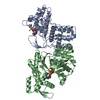 8jo4C C: citing same article ( |
|---|---|
| Similar structure data | Similarity search - Function & homology  F&H Search F&H Search |
- Links
Links
- Assembly
Assembly
| Deposited unit | 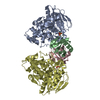
| ||||||||
|---|---|---|---|---|---|---|---|---|---|
| 1 |
| ||||||||
| Unit cell |
|
- Components
Components
| #1: Protein | Mass: 50767.090 Da / Num. of mol.: 2 / Mutation: C226A Source method: isolated from a genetically manipulated source Source: (gene. exp.)  Legionella pneumophila subsp. pneumophila str. Philadelphia 1 (bacteria) Legionella pneumophila subsp. pneumophila str. Philadelphia 1 (bacteria)Gene: lpg2526 / Production host:  #2: Protein | Mass: 8576.831 Da / Num. of mol.: 2 Source method: isolated from a genetically manipulated source Source: (gene. exp.)  Homo sapiens (human) / Gene: UBB / Production host: Homo sapiens (human) / Gene: UBB / Production host:  #3: Chemical | Has ligand of interest | Y | |
|---|
-Experimental details
-Experiment
| Experiment | Method:  X-RAY DIFFRACTION / Number of used crystals: 1 X-RAY DIFFRACTION / Number of used crystals: 1 |
|---|
- Sample preparation
Sample preparation
| Crystal | Density Matthews: 2.41 Å3/Da / Density % sol: 48.87 % |
|---|---|
| Crystal grow | Temperature: 289 K / Method: vapor diffusion, hanging drop / pH: 6 Details: 100 mM sodium acetate, pH 6.0, 160 mM ammonium sulfate, 21% PEG 4000, 20% glycerol |
-Data collection
| Diffraction | Mean temperature: 100 K / Serial crystal experiment: N |
|---|---|
| Diffraction source | Source:  SYNCHROTRON / Site: SYNCHROTRON / Site:  SSRF SSRF  / Beamline: BL17U1 / Wavelength: 0.979183 Å / Beamline: BL17U1 / Wavelength: 0.979183 Å |
| Detector | Type: DECTRIS EIGER X 16M / Detector: PIXEL / Date: Nov 19, 2020 |
| Radiation | Protocol: SINGLE WAVELENGTH / Monochromatic (M) / Laue (L): M / Scattering type: x-ray |
| Radiation wavelength | Wavelength: 0.979183 Å / Relative weight: 1 |
| Reflection | Resolution: 2.95→49.38 Å / Num. obs: 25049 / % possible obs: 99.8 % / Redundancy: 5.9 % / CC1/2: 0.996 / Rmerge(I) obs: 0.139 / Rpim(I) all: 0.062 / Rrim(I) all: 0.153 / Χ2: 0.98 / Net I/σ(I): 10.8 / Num. measured all: 146652 |
| Reflection shell | Resolution: 2.95→3.12 Å / % possible obs: 99.2 % / Redundancy: 6 % / Rmerge(I) obs: 0.831 / Num. measured all: 23533 / Num. unique obs: 3946 / CC1/2: 0.881 / Rpim(I) all: 0.368 / Rrim(I) all: 0.91 / Χ2: 1.01 / Net I/σ(I) obs: 2.2 |
- Processing
Processing
| Software |
| ||||||||||||||||||||||||||||||||||||||||||||||||||||||||||||||||||||||
|---|---|---|---|---|---|---|---|---|---|---|---|---|---|---|---|---|---|---|---|---|---|---|---|---|---|---|---|---|---|---|---|---|---|---|---|---|---|---|---|---|---|---|---|---|---|---|---|---|---|---|---|---|---|---|---|---|---|---|---|---|---|---|---|---|---|---|---|---|---|---|---|
| Refinement | Method to determine structure:  MOLECULAR REPLACEMENT / Resolution: 2.95→19.19 Å / SU ML: 0.33 / Cross valid method: THROUGHOUT / σ(F): 1.34 / Phase error: 25.24 / Stereochemistry target values: ML MOLECULAR REPLACEMENT / Resolution: 2.95→19.19 Å / SU ML: 0.33 / Cross valid method: THROUGHOUT / σ(F): 1.34 / Phase error: 25.24 / Stereochemistry target values: ML
| ||||||||||||||||||||||||||||||||||||||||||||||||||||||||||||||||||||||
| Solvent computation | Shrinkage radii: 0.9 Å / VDW probe radii: 1.11 Å / Solvent model: FLAT BULK SOLVENT MODEL | ||||||||||||||||||||||||||||||||||||||||||||||||||||||||||||||||||||||
| Refinement step | Cycle: LAST / Resolution: 2.95→19.19 Å
| ||||||||||||||||||||||||||||||||||||||||||||||||||||||||||||||||||||||
| Refine LS restraints |
| ||||||||||||||||||||||||||||||||||||||||||||||||||||||||||||||||||||||
| LS refinement shell |
|
 Movie
Movie Controller
Controller




 PDBj
PDBj
